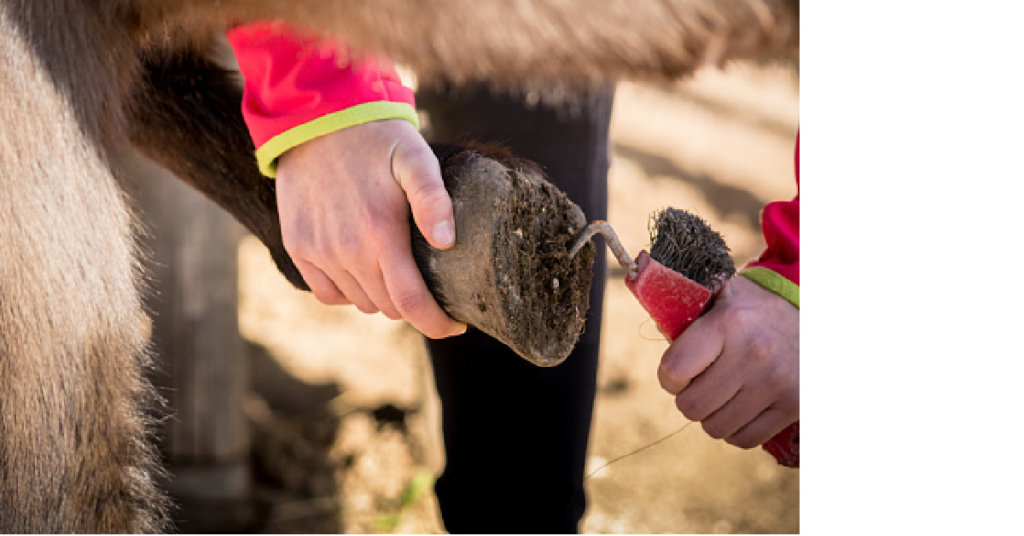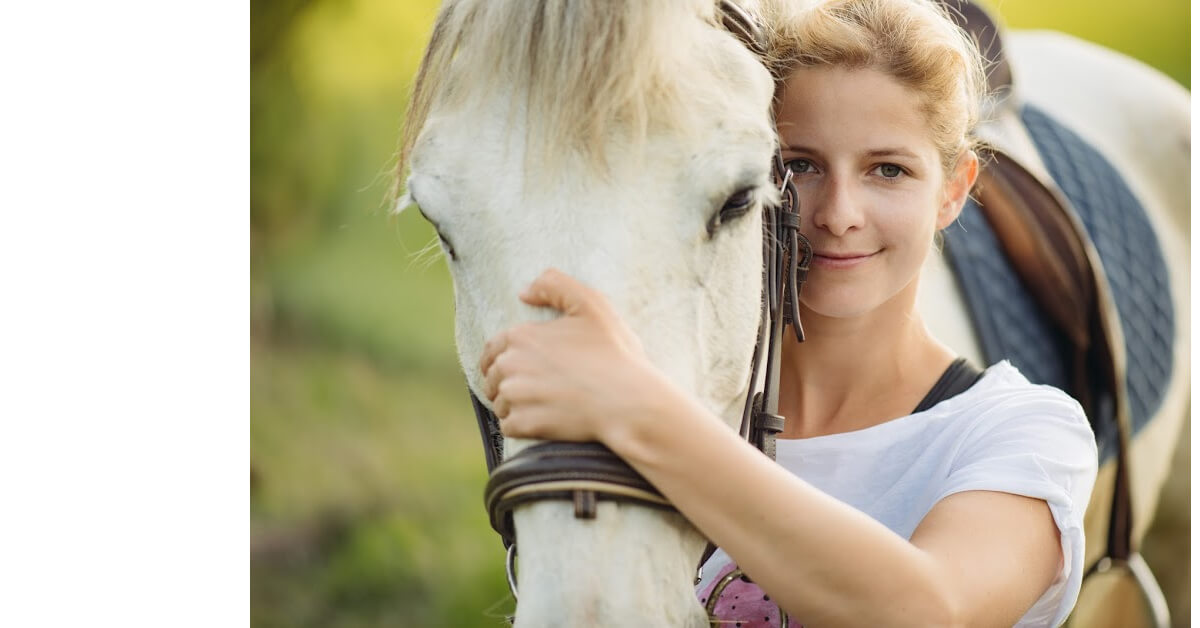“No hoof, no horse.”
Here are four necessary steps to take care of horses hooves and avoid horse hoof problems.
Look for the horse hoof cleaning tools mentioned throughout this post. They are marked in blue. For instance, if you push on the blue words, they will take you to Amazon, where you can discover many styles. If you decide to purchase anything from Amazon from this link, I earn from qualifying purchases as an Amazon Associate. At no cost to you.


1. A hoof pick is used to clean out the bottom of a horse hoof
It is crucial to avoid horse hoof problems by frequently using a hoof pick to pick out the dirt from the bottom of a horse’s hoof. Horses that continually stand in manure, muck, mud, etc., can be susceptible to thrush. Thrush is a condition that is easily maintained and avoided with proper care. But, if ignored, it can become a problem. It should be a habit to pick out the horse’s hooves before and after a ride.
Use the diagram below to see where the different hoof parts are marked. We want to clean out all the debris to expose the sole when using a hoof pick. Ensure that you clean well around the frog. It is shaped like a triangle. Don’t pick so hard that you might reach sensitive tissues, but firmly enough to bring out all the dirt from the crevices. It takes practice. I always recommend a person with knowledge of horses and safety around horses to teach a new horse person.

It may seem scary at first, picking up a horse’s leg. But, you get used to it, and it becomes easy and a normal thing to do. Most horses are used to this because it is one thing that we teach a horse when they are firstborn. It shows trust in humans because horses are vulnerable without a foot on the ground.
This video is of Grace showing how to clean Finn’s hoof.
As a person new to horses, I hope you have found a horse accustomed to this skill of Horsemanship. If it is not, I would call in a professional horse person or a farrier to ensure you are safe with the procedure. They will have pointers to give you new horse confidence.
While learning horsemanship skills, it’s a given that most riding lesson programs teach hoof cleaning. It should be a regular part of anyone’s lesson. The teacher will demonstrate and monitor the student until they are comfortable and confident.
Grace stands confidently next to Finn’s shoulder and faces the rear. Her feet are safe to the side so that if the horse drops down, it won’t hit her toe or foot. Notice she is wearing safe footwear while working around Finn.
Never lean down on your knees. When working with a horse, the person should always be ready to react quickly and push themselves away from the horse with their feet. If they are on their knees, they may get caught up with the horse’s legs and injured.
First, Grace rubs her hand on Finn’s shoulder and down his leg. She is warning him that she is there. And making sure he is aware. Rubbing her hand down his leg, she tells him that she wants him to lift his leg.
When she reaches the cannon bone, she applies slight pressure to his tendons in the back of the bone, which then tells Finn to lift his hoof. As he does, she wraps her hand around the hoof and begins to clean out his hoof with a hoof pick. She checks around the frog and under the horseshoe for rocks or debris. She then brushes it out and gently lets the horse’s hoof fall to the ground.
Until a person knows what the horse’s reactions might be, they should help the hoof settle to the ground and not just drop it.
When it hits the ground, it might startle the horse and cause him to jump. That could make a dangerous situation for both horse and rider.
I also want to point out that Grace is a new student, and we did discuss that it is much safer to wear a helmet when working around horses. You never know when something will startle the horse, and they might knock you down or even reach quickly up with their hoof and hit you in the head.

2. Hoof Conditioner can be painted on horses hoof
Some people use a hoof conditioner. Conditioners applied like fingernail polish to the outside and bottom of the hoof. I used to use a product with pine tar 40 some years ago. Fieblings Hoof Conditioner. But, now, as with everything else, they have multiple types of hoof conditioners out on the market. Years of research have found that a horse with a healthy lifestyle and regular, proper farrier work most likely is not affected either with or without conditioner. A farrier should tell if a horse’s hooves will benefit.

3.Clean stalls, paddocks, etc. Anywhere the horse will be living
Horse hoof care begins where a horse lives. You must keep manure and pee, soaked debris, mud, and muck to a minimum. Keeping the areas where they roam, graze, and live free from debris will help avoid debilitating or catastrophic injuries.
Depending on the length of time a horse is pinned in an area determines how often the site needs to be cleaned. They make manure forks that make this so easy and quick. A manure shovel is a great tool to strip a stall. I always say that a stall needs picked every 12 hours and stripped every 24 hours.
A good schedule for cleaning is morning and evening. We would pick the stall after feeding time, which means going through and removing the stall’s manure and any soaked shavings or straw. Shavings are like sawdust but not as refined. You can look at this link that shows a bag of shavings. This link shows a bag of shavings from Amazon. We usually go to the farm store where bags of shavings cost less. We should not use Walnut or cedar shavings because they are toxic to horses.
Stripping a stall is where the shavings are entirely scraped down and removed from the stall base. Then fresh shavings will be put in the stall. If the stall is being cleaned daily, stripping a stall can be done every other day.
Cleaning a stall always depends on the horse’s housekeeping ways. Some poo in a corner, some horses end up mixing it up as they walk around the stall.
Of course, anytime we remove manure or pee from an area is good Horsemanship. Watch for a future post about Horsemanship and what it means.

as well as can determine if a horse has shoes or no shoes
4.Proper footing for each discipline is a way to avoid horse hoof problems
Proper footing makes a difference to a horses’ hooves. Footing is the material the horse’s hoof becomes in contact with. Footing covers the ground or base to create a comfortable place for the horse to place its foot during activity.
A trail horse’s hooves may come in touch with rocks and gravel, whereas a pleasure horse comes into contact with softer sandlike footing. Footing depth for Jumpers is different for Barrel Racers. Cross Country gallop across footing that is ground and grass. Stadium jumping or Dressage footing differs in depth.
Each discipline requires properly trimmed horse hoof or shoe placement to prevent injuries to a horse while performing a specific discipline. The angles, depth, and straightness in a horse’s hoof trimming affect how a horse moves. In the same sense that I wear orthotics to help keep my ankles from pronating. A farrier understands the mechanics of a hoof and how it affects the leg, shoulder, neck, and back of a horse. And just the opposite, how a horse’s hoof is trimmed and if it wears it wears can affect its body alignment.
This is why it is essential to find a farrier trained and studied under a journeyman. However, not all farriers are equal, even with certification. So ask around for references and experiences of a certain farrier.
I hope the above post helps you understand ways to avoid horse hoof problems. If you have any questions, please comment below. Watch for more posts in the “No hoof, no horse” Category.

